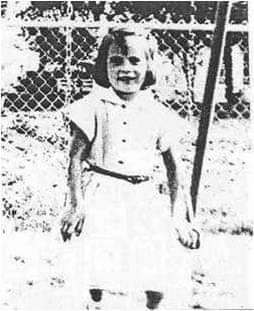Who killed Barbara Gaca

67 years on, Detroit still wonders who snatched and murdered seven-year-old Barbara Gaca
On that damp, bleak Thursday when little Barbara Gaca skipped off to school and never returned, she was settled into a routine as comfortably predictable as the route her father, Frank, followed every day for 38 years as a Detroit mail carrier.
Every morning she dressed in her blue-and-white school uniform and black strap shoes, kissed her mother goodbye, then walked the six blocks from the frame house at 14102 Faircrest to Assumption Grotto, one of the city’s largest Catholic parishes. The second-grader attended Mass, had breakfast at her desk, then began a long day of study under the watchful eyes of the nuns. Noon provided a welcome break for Barbara and her younger siblings, Gloria and Robert, who weren’t allowed to watch television until Barbara came home and personally clicked it on. Then they all had lunch with Soupy Sales.
But on March 24, 1955, Barbara didn’t come home for lunch. Her mother called the school office. Barbara hadn’t shown up at school today, Rita Gaca was told. Wasn’t she homesick?
“Mom was anxious, then angry, then anger turned to despair,” remembers Robert Gaca, now 55 and living near Lansing. “It didn’t take long for her to fall apart.”
Police issued a bulletin for the lost youngster. Frank Gaca left work to join friends and relatives in searching the neighborhood around Gratiot and McNichols. As darkness fell, more and more police were sent out to look for the slender brown-eyed girl in the blue snowsuit and print babushka. By the following day, thousands of concerned Detroiters were turning the city upside down. “Knock on every door,” police and volunteers were told.
“Look under every car. Check everywhere a little girl possibly could be.”
Garages, confessionals, garbage cans, and abandoned refrigerators were scoured. The nuns and 1,100 students at Assumption said rosaries. On Friday night, Frank Gaca made a televised appeal, asking whoever had his daughter to set her free. Snowfall didn’t deter 3,000 Boy Scouts from combing a 90-square-mile area the next day. Meanwhile, police rounded up every known pervert and contended with a flurry of tips, rumors, and hoaxes.
On March 31, the largest search in local memory ended when a railroad worker came across Barbara’s body wrapped inside an Army blanket. She had been raped, strangled, stabbed, then discarded like so much trash at an Oakland County dump site, 25 miles from her home. Detroit Mayor Albert Cobo was so upset by the news, that he broke down and wept in public.
“What are we going to do?” he cried. “What can we do? A little girl like this — it just seems we have to build a chain around our children!”
At one point 60 detectives were assigned to work overtime on the case, but by 1957 the investigation had lost much of its steam. After two years, police had chased down 1,974 tips, looked at 850 suspects, and still were no closer to solving the mystery.
Was it the man in the confessional, a guest priest at the kidnapped girl's family church, who was shipped to a parish in Nova Scotia immediately after her body was found? Or was it the man who confessed, Paul Hassell, a child-bothering Ford worker from the other side of town, who committed suicide soon after admitting the crime a dozen years later?
What about the child-molesting mailman who missed work that day, or a relative or maybe a friend who, early on, had slipped through investigators' hands -- someone the shy girl trusted? Or maybe William Henry Redmond, an itinerant carnival worker who later died awaiting trial for the rape and strangulation of an 8-year-old Philadelphia girl -- a usual suspect for a child-related crime? Could it have been a man who, years later, after early brushes with authority, ran a business in Detroit, was law-abiding, and enjoyed a stable family life?
Whomever -- the killer of seven-year-old Barbara Gaca (pronounced GAHT-za) that raw March Thursday in 1955 left an unforgettable scene:
Crime scene and autopsy photos show a ponytailed girl in almost angelic repose — knees drawn up, eyes and mouth closed — but with her frail torso punctured by 15 stab wounds. A memo refers to the presence of chocolate-coated peppermint candy in her stomach: “She died shortly after and was emotionally upset after eating the candy. It was only partially digested.”
In addition, she'd been raped. Brutally.
Richard Bak's 2009 article in Hour Detroit is a must: Who Killed Barbara Gaca? the headline reads; its text lays out the facts in a page-turning fashion.
Barbara Gaca never made it to her second-grade class that day. Clad in blue and white uniform, the slender brown-eyed girl in the blue snowsuit and print babushka, on her way to school at the Assumption Grotto parish, vanished completely -- until she was found a week later. In the meanwhile,
Garages, confessionals, garbage cans, and abandoned refrigerators were scoured. The nuns and 1,100 students at Assumption said rosaries. On Friday night, her father, Frank Gaca, made a televised appeal, asking whoever had his daughter to set her free. Snowfall didn’t deter 3,000 Boy Scouts from combing a 90-square-mile area the next day. Meanwhile, police rounded up every known pervert and contended with a flurry of tips, rumors, and hoaxes.
Her body was found by a railroad worker on March 31st, a week later.
Of the killing, a popular crime magazine of the time, True Detective, branded the city, after Barbara Gaca became the sixth child murdered there in eight years, "a kid killers town."
That telling reputation, if unfair, is still intact, seven decades later.
Who killed Barbara Gaca? Almost 67 years on, we still don't know. Which suspect sounds most likely to you?
Source

 My First News Item
My First News Item My Nine News Item
My Nine News Item